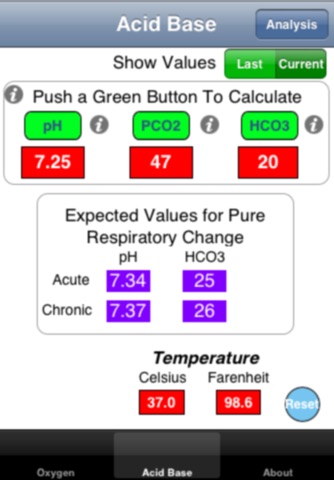
Blood Gas Analysis app for iPhone and iPad
Developer: TepMed Inc.
First release : 05 Oct 2012
App size: 603.32 Kb
This application calculates and interprets blood gas oxygenation and acid-base status. It has three main tabs: Oxygen; Acid Base and About.
Oxygen Tab
By entering a number for PO2, oxygen saturation or oxygen content the other two values are calculated. Default values for temperature, hemoglobin concentration, barometric pressure pH, PCO2 FIO2, and respiratory quotient may be changed by the user. Changing any of the first five of these parameters will cause PO2, saturation and content to be recalculated. In addition, the PAO2 is calculated from the FIO2 and barometric pressure. The PaO2:FIO2 ratio and the Alveolar-Arterial Partial Pressure Difference are calculated from the appropriate parameters by assuming the PO2 reflects an arterial value.
Acid Base Tab
There are three acid base views. The first, which is shown by clicking the Acid Base tab, calculates the pH, PCO2 or HCO3, corrected for a default or user-entered temperature, from any of the other two user-entered numbers. It also shows the expected acute and chronic pH and HCO3 for a pure respiratory disorder. An analysis view shows the corrected and uncorrected anion gaps, the anion gap ratio, the base excess, the strong ion difference, the effective strong ion difference, the strong ion gap and the expected normal PCO2 compensation and the resultant pH. Default values for albumin and the electrolytes: sodium; potassium; chloride; phosphate; calcium and magnesium, can be changed using the units mmol/L, mEq/L or mg/dl. Such changes will affect the anion gaps and strong ion differences. A third view shows interpretations of the acid base abnormalities and explains the reasoning behind the interpretation using any of three methods: 1) pH, PCO2 and anion gap; 2) pH, PCO2, base excess and anion gap or 3) strong ion difference, effective strong ion difference and strong ion gap.
About Tab
From this tab, the user may view a detailed help file with examples, change the default values for the electrolytes and albumin and set the calculation of the corrected and uncorrected anion gaps to include or exclude (the default) potassium. One may also review the terms-of-use information and view contact information.



